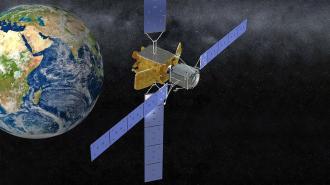China has used a space tug to change the orbit of a defunct satellite — proving that it’s a viable way to clean up some of our planet’s space junk.
The challenge: Earth’s orbit is cluttered with defunct satellites, discarded rocket parts, and countless bits of debris we’ve sent into space.
Because this space junk is moving nearly 10 times faster than a speeding bullet, a collision from something as small as a screw could cause serious damage to satellites and spacecraft. If those craft have astronauts on board, the results could be catastrophic.
The idea: The aerospace industry has been exploring ways to rid Earth’s orbit of all this debris, and space tugs are one possible solution.
These spacecraft would attach themselves to defunct satellites or other space junk and then tow them down to burn up in Earth’s atmosphere or into an orbit that isn’t used by operational spacecraft (known as a “graveyard orbit”).
A collision from something as small as a screw could cause serious damage to satellites in space.
What’s new: While the idea of a space tug has been around since the 1950s, it wasn’t until 2020 that Northrop Grumman finally proved that it is possible for one satellite to safely grab hold of another. (But that was a refueling mission and not a deorbiting one.)
China has now surprised the world by demonstrating that it, too, can grab a satellite and move it into a graveyard orbit — although the circumstances surrounding the demonstration are raising eyebrows.
China’s space tug: California’s ExoAnalytic Solutions operates the largest optical telescope network in the world, which it uses to monitor orbiting spacecraft.
On January 22, it noticed that China’s ShiJian-21 (SJ-21) satellite was no longer in its typical orbit. The firm did some investigating and found that the satellite had been in close proximity to a defunct Chinese satellite, CompassG2, about 72 hours prior.
A space tug can send a defunct satellite to burn up in Earth’s atmosphere or to a “graveyard orbit.”
SJ-21 apparently docked with CompassG2, as it spent several days pulling the dead satellite through space, but the docking must have taken place during daylight hours, since Exo’s telescopes weren’t able to capture it.
When SJ-21 released the dead satellite, it sent it into an elliptical orbit ranging in altitude from 22,416 to 24,162 miles. Graveyard orbit is typically symmetrical, at an altitude of 22,400 miles.
Matter of perspective: When China launched SJ-21 in October 2021, state media reported that it would be used to “test and verify space debris mitigation technologies.”
But the daylight maneuvering, odd orbit, and fact that China has yet to confirm the operation has some people concerned that it plans to use the capability to interfere with other countries’ spacecraft.
“[Y]ou could use the lens that a lot of the US-based China watchers use and say that this could indicate that China is developing an on-orbit offensive capability,” Victoria Samson, Washington Office director at the Secure World Foundation, told Space News.
All we know for sure right now, though, is that China has successfully used a space tug to move a defunct satellite, and in the context of cleaning up space junk, that’s a step forward for the aerospace industry.
We’d love to hear from you! If you have a comment about this article or if you have a tip for a future Freethink story, please email us at [email protected].






